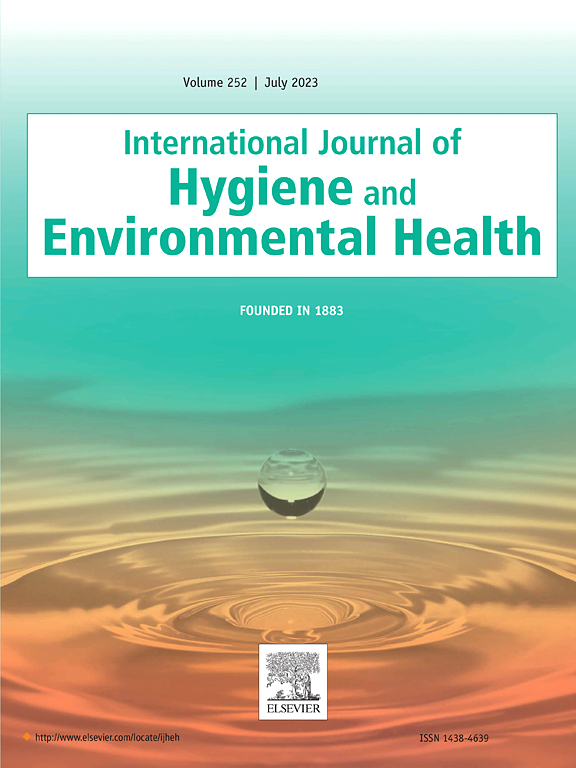Extensive exposure to di-n-hexyl phthalate with significant seasonal variation across infants, children and adults including pregnant women in Denmark
IF 4.4
2区 医学
Q1 INFECTIOUS DISEASES
International journal of hygiene and environmental health
Pub Date : 2025-06-24
DOI:10.1016/j.ijheh.2025.114614
引用次数: 0
Abstract
Background
Di-n-hexyl phthalate (DnHxP) is one of the most potent phthalates with adverse effects on the male reproductive system. Despite a European ban on DnHxP since 2020, high urinary excretion of mono-n-hexyl phthalate (MnHxP), the major metabolite of DnHxP, has been observed in recent European human biomonitoring (HBM) studies. Sunscreen products containing the UV-filter diethylamino hydroxybenzyl hexyl benzoate (DHHB), which can be contaminated with DnHxP, were pointed out as a relevant source of exposure to DnHxP.
Objective
To study possible seasonal variation in urinary excretion of MnHxP in different Danish study populations.
Method
MnHxP was measured by LC-MS/MS in 1591 urine samples collected in 2016–2022 from pregnant women, 7-year-old children, and infants and their parents participating in three different cohort studies.
Results
Urinary MnHxP was above the limit of detection (0.04 μg/L) in 84 % and above 1 μg/L in 33 % of samples. The 7-year-old children was the study population with the highest excretion rate (97 %). The highest urinary MnHxP concentration (72.5 μg/L) exceeded the health-based guidance value (HBM-I value) of 60 μg/L.
A significantly higher urinary excretion of MnHxP was observed in the summer compared to the winter season in all study populations. 80 % of the urine samples with MnHxP concentrations > 1 μg/L were from the summer season. 40 % of Danish sunscreen products contain DHHB.
Conclusion
The marked seasonal variation with higher MnHxP excretions in the summer season supports the hypothesis that the recently unveiled DnHxP contamination of the UV-filter DHHB in sunscreen products could be driving these exposures.
在丹麦,婴儿、儿童和成人(包括孕妇)广泛接触邻苯二甲酸二正己酯,且季节性差异显著
邻苯二甲酸二正己酯(DnHxP)是对男性生殖系统影响最大的邻苯二甲酸酯之一。尽管欧洲自2020年起禁止使用DnHxP,但在最近的欧洲人类生物监测(HBM)研究中发现,DnHxP的主要代谢物邻苯二甲酸单-正己酯(MnHxP)的尿排泄量很高。含有紫外线过滤剂二乙胺羟基苄基己基苯甲酸酯(DHHB)的防晒产品可能被DnHxP污染,被指出是DnHxP的相关暴露源。目的研究丹麦不同人群尿MnHxP的季节性变化。方法采用LC-MS/MS对2016-2022年3项不同队列研究中1591份孕妇、7岁儿童、婴儿及其父母的尿液样本进行mnhxp测定。结果84%的样品中MnHxP的检出限高于0.04 μg/L, 33%的样品中MnHxP的检出限高于1 μg/L。7岁儿童是排泄率最高的研究人群(97%)。尿MnHxP最高浓度(72.5 μg/L)超过60 μg/L的健康指导值(HBM-I值)。在所有研究人群中,夏季尿中MnHxP的排泄量明显高于冬季。80%尿样含有MnHxP浓度>;1 μg/L来自夏季;40%的丹麦防晒产品含有DHHB。结论在夏季MnHxP的高排泄量的显著季节性变化支持了最近发现的防晒产品中紫外线过滤器DHHB中DnHxP污染可能导致这些暴露的假设。
本文章由计算机程序翻译,如有差异,请以英文原文为准。
求助全文
约1分钟内获得全文
求助全文
来源期刊
CiteScore
11.50
自引率
5.00%
发文量
151
审稿时长
22 days
期刊介绍:
The International Journal of Hygiene and Environmental Health serves as a multidisciplinary forum for original reports on exposure assessment and the reactions to and consequences of human exposure to the biological, chemical, and physical environment. Research reports, short communications, reviews, scientific comments, technical notes, and editorials will be peer-reviewed before acceptance for publication. Priority will be given to articles on epidemiological aspects of environmental toxicology, health risk assessments, susceptible (sub) populations, sanitation and clean water, human biomonitoring, environmental medicine, and public health aspects of exposure-related outcomes.

 求助内容:
求助内容: 应助结果提醒方式:
应助结果提醒方式:


